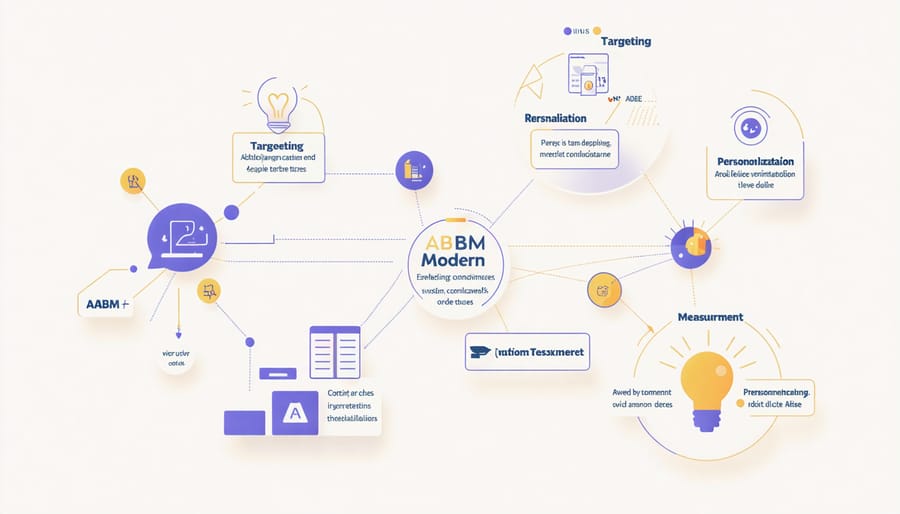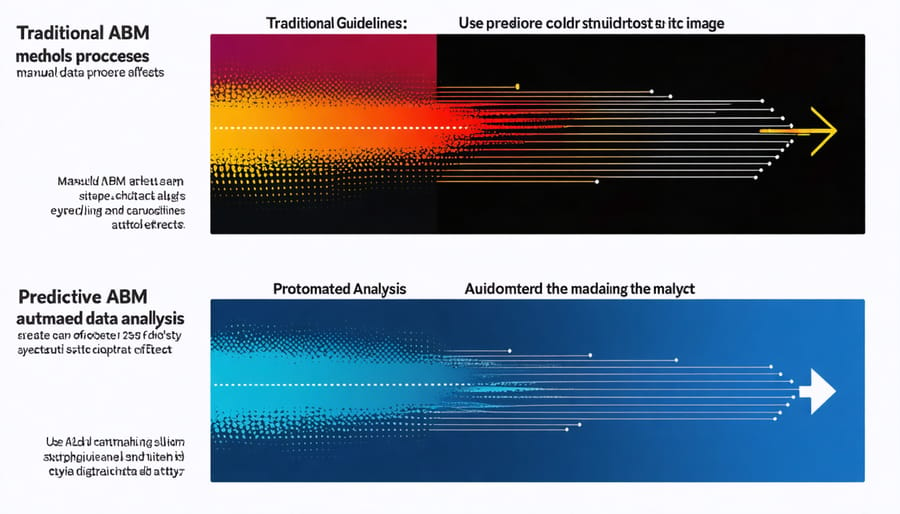How Predictive Analytics Transforms Account-Based Marketing (With Real Results)

Transform your marketing strategy with account-based marketing (ABM), a precision-driven approach that treats individual high-value accounts as distinct markets. Unlike traditional broad-reach marketing, ABM harnesses predictive analytics and customer data to deliver personalized campaigns that resonate with specific decision-makers within target organizations.
Today’s ABM has evolved beyond simple account targeting into a sophisticated, data-powered methodology. By combining artificial intelligence, behavioral analytics, and deep customer insights, modern ABM platforms enable marketers to identify, engage, and convert premium accounts with unprecedented accuracy. This strategic shift has delivered remarkable results, with organizations reporting up to 200% increases in marketing ROI when implementing well-structured ABM programs.
As businesses increasingly prioritize efficient resource allocation and measurable returns, understanding and implementing ABM has become crucial for staying competitive. Whether you’re a B2B startup looking to land enterprise clients or an established corporation aiming to expand market share, mastering account-based marketing’s core principles and technological capabilities is essential for driving sustainable growth in today’s digital-first business landscape.
Account-Based Marketing: The Modern Definition
Core Components of Modern ABM
Modern ABM strategies are built on several interconnected components that work together to create targeted, personalized campaigns. At the foundation is robust data analytics, which enables companies to identify and profile high-value accounts with precision. This data-driven approach is enhanced by AI-driven personalization, allowing marketers to deliver tailored content and experiences at scale.
Account selection and prioritization form the second crucial component, where businesses use specific criteria to identify and rank potential accounts based on their likelihood to convert. This is followed by cross-functional alignment, particularly between sales and marketing teams, ensuring consistent messaging and coordinated outreach efforts.
Personalized content creation and multi-channel engagement represent the next vital elements, enabling businesses to reach decision-makers through various touchpoints with relevant, customized messaging. Finally, measurement and optimization complete the framework, with clear KPIs and tracking mechanisms to assess campaign effectiveness and adjust strategies accordingly.
These components work in concert to create a sophisticated, targeted approach that yields higher ROI than traditional marketing methods.

Traditional vs. Predictive ABM Approaches
Traditional ABM approaches relied heavily on manual processes and intuition, with sales teams identifying target accounts based on past experiences and basic firmographic data. This method often led to inefficient resource allocation and missed opportunities.
In contrast, modern predictive ABM leverages advanced analytics and machine learning to identify and prioritize accounts with the highest potential value. By analyzing vast amounts of data points – including digital behavior, purchase history, and market signals – predictive ABM creates more accurate targeting models and personalized engagement strategies.
The advantages of predictive ABM are significant. While traditional methods might capture 20-30% of potential opportunities, predictive approaches can identify up to 75% of high-value prospects. This data-driven methodology enables companies to:
– Automate account scoring and prioritization
– Detect early buying signals
– Predict customer needs before they arise
– Scale personalization efforts efficiently
– Measure and optimize campaigns in real-time
The shift from traditional to predictive ABM represents more than just technological advancement – it’s a fundamental change in how businesses identify, engage, and convert their most valuable accounts.

Predictive Analytics in ABM: The Game Changer
Key Predictive Metrics That Matter
To effectively measure your account-based marketing success, focus on these key predictive metrics that provide actionable insights. Customer Lifetime Value (CLV) projection stands as a primary indicator, helping you forecast the long-term value of targeted accounts and adjust your strategy accordingly.
Engagement velocity tracks how quickly and deeply target accounts interact with your content across channels. Monitor metrics like page views per account, content downloads, and time spent on site to predict which accounts are most likely to convert.
Account penetration rate measures how many key stakeholders within a target account are engaging with your brand. Higher penetration typically indicates greater chances of successful conversion and helps identify accounts ready for focused sales outreach.
Intent signals tracking reveals behavioral patterns that indicate buying readiness. These include specific keyword searches, competitor comparison activities, and industry-specific content consumption. Combined with predictive scoring models, these signals help prioritize accounts most likely to purchase.
Pipeline velocity metrics show how quickly accounts move through your sales funnel. Track average deal size, sales cycle length, and win rates to predict revenue potential and resource allocation needs.
Remember to monitor return on investment (ROI) indicators such as cost per account acquisition, campaign attribution, and revenue influence. These metrics help validate your ABM strategy and justify continued investment in targeted accounts.
Automated Intelligence in Target Account Selection
In today’s data-driven business landscape, artificial intelligence has revolutionized how companies identify and select target accounts for their ABM strategies. Through advanced machine learning automation, businesses can now analyze vast amounts of data to identify ideal customer profiles with unprecedented accuracy.
AI-powered systems evaluate multiple data points simultaneously, including company size, revenue, industry trends, technological adoption rates, and buying signals across digital channels. This comprehensive analysis helps organizations move beyond basic firmographic data to understand the true potential of prospective accounts.
The automated intelligence systems can:
– Score accounts based on their likelihood to convert
– Predict customer lifetime value
– Identify accounts showing active buying behavior
– Recognize patterns in successful past engagements
– Flag accounts that match ideal customer profiles
These capabilities significantly reduce the manual effort required in account selection while improving accuracy. Marketing teams can now focus their resources on accounts with the highest potential return on investment, rather than casting a wide net based on intuition alone.
The real power lies in the system’s ability to learn and improve over time. As more data is collected and outcomes are recorded, the AI continually refines its selection criteria, leading to increasingly precise target account recommendations and better allocation of marketing resources.
Implementing Predictive ABM Successfully
Technology Stack Requirements
To effectively implement predictive account-based marketing, organizations need a robust technology stack that combines data analytics, automation, and customer relationship management tools. The foundation typically starts with a comprehensive CRM system that integrates seamlessly with marketing automation platforms. These systems work together to track customer interactions, manage leads, and deliver personalized B2B content strategies at scale.
Essential components include:
– Data Management Platform (DMP) for collecting and organizing customer data
– Customer Data Platform (CDP) for unified customer profiles
– Marketing Automation Software for campaign execution
– Predictive Analytics Tools for behavior modeling
– Intent Data Platforms for tracking buying signals
– Account Engagement Software for monitoring interaction
– Attribution Tools for measuring campaign success
When selecting these tools, ensure they offer:
– Real-time data processing capabilities
– API integration flexibility
– Advanced segmentation features
– Multi-channel campaign management
– Automated workflow capabilities
– Comprehensive reporting dashboards
The key is choosing solutions that integrate smoothly with your existing infrastructure while providing scalability for future growth. Start with core components and gradually expand your stack based on specific business needs and resource availability. Regular evaluation of tool performance ensures optimal ROI and effectiveness in your ABM strategy.

Data Integration Best Practices
Effective data integration is crucial for successful account-based marketing implementation. Start by establishing a centralized data warehouse that combines information from various sources, including CRM systems, marketing automation platforms, and social media analytics. Ensure your data security practices comply with industry regulations and maintain customer trust.
Implement these key practices for optimal results:
1. Regular data cleansing and validation to maintain accuracy
2. Standardized data formats across all platforms
3. Automated data syncing between systems
4. Clear documentation of data sources and processing methods
Create a systematic approach to data collection by:
– Defining relevant metrics and KPIs
– Establishing data collection schedules
– Setting up automated reporting systems
– Implementing quality control measures
Focus on collecting actionable data points that directly inform your ABM strategy:
– Account engagement metrics
– Customer behavior patterns
– Purchase history
– Communication preferences
– Decision-maker profiles
Regular audits of your data integration processes ensure continued effectiveness and identify areas for improvement. Consider implementing AI-driven tools to automate data analysis and generate actionable insights. Remember to maintain compliance with privacy regulations while collecting and processing customer data.
Account-based marketing represents a strategic shift in how businesses approach their target accounts, combining personalization with data-driven decision-making. As we’ve explored, ABM enables companies to focus their resources on high-value accounts while leveraging predictive analytics to enhance targeting and engagement.
To implement ABM effectively, start by identifying your ideal customer profiles and selecting target accounts that align with your business goals. Build a cross-functional team involving sales, marketing, and customer success to ensure aligned messaging and coordinated efforts. Invest in the right technology stack to support your ABM initiatives, including CRM systems and marketing automation platforms.
Remember that successful ABM is an iterative process. Begin with a pilot program targeting a small number of accounts, measure results, and adjust your strategy based on data-driven insights. Focus on creating personalized content and experiences that address specific pain points of your target accounts.
By embracing ABM and continuously refining your approach, you’ll be better positioned to build stronger relationships with high-value accounts and achieve better ROI from your marketing efforts. Start small, stay focused, and scale your program as you see success.
Leave a Reply